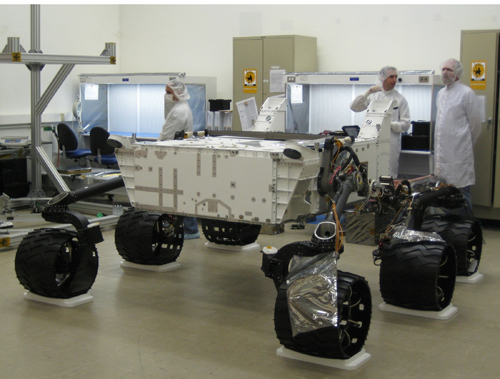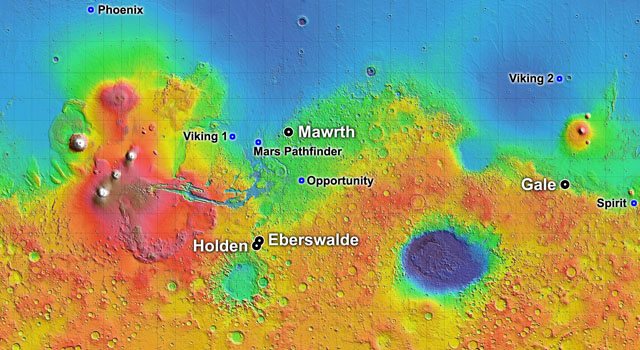Landing sites for the Mars Science Laboratory have been narrowed down to four intriguing places on the Red Planet. The car-sized rover will have the capability to travel to more scientifically compelling sites, and with its radioisotope power source, it won’t need to rely on solar power, allowing for more flexibility in locations say project leaders at the Jet Propulsion Laboratory. After seeking input from international experts on Mars and engineers working on the landing systems, here are the four sites JPL announced (drumroll)…
Oh, before listing the sites, NASA is having a name the rover contest for MSL, so check that out, too!
Eberswalde: where an ancient river deposited a delta in a possible lake, south of Mars equator.
Gale: a crater with a mountain within that has stacked layers including clays and sulfates, near the equator. This was a favorite site for the Mars Exploration Rovers, but it was deemed to hazardous for them. Not so for MSL.
Holden: a crater containing alluvial fans, flood deposits, possible lake beds and clay-rich deposits, in the southern hemisphere.
Mawrth: , which shows exposed layers containing at least two types of clay, in the northern hemisphere, near the edge of a vast Martian highland.
“All four of these sites would be great places to use our roving laboratory to study the processes and history of early Martian environments and whether any of these environments were capable of supporting microbial life and its preservation as biosignatures,” said John Grotzinger of the California Institute of Technology, Pasadena. He is the project scientist for the Mars Science Laboratory.

During the past two years, multiple observations of dozens of candidate sites by NASA’s Mars Reconnaissance Orbiter have augmented data from earlier orbiters for evaluating sites’ scientific attractions and engineering risks.
JPL is assembling and testing the Mars Science Laboratory spacecraft for launch in fall 2009.
“Landing on Mars always is a risky balance between science and engineering. The safest sites are flat, but the spectacular geology is generally where there are ups and downs, such as hills and canyons. That’s why we have engineered this spacecraft to make more sites qualify as safe,” said JPL’s Michael Watkins, mission manager for the Mars Science Laboratory. “This will be the first spacecraft that can adjust its course as it descends through the Martian atmosphere, responding to variability in the atmosphere. This ability to land in much smaller areas than previous missions, plus capabilities to land at higher elevations and drive farther, allows us consider more places the scientists want to explore.”
MSL is designed to hit a target area roughly 20 kilometers (12 miles) in diameter. Also, a new “skycrane” technology to lower the rover on a tether for the final touchdown can accommodate more slope than the airbag method used for Spirit and Opportunity.
Source: JPL


It’s too bad they can’t land it in the bottom of Valles Marineris. Exploring the layers of sediment and caves would be truly cool.
Can’t wait until this beast is on Mars!
the ship should be named the Cheney Rover
This will be an tremendously exciting mission – very much looking forward to seeing the results.
It’s a pity we have to use an atomic battery to power the vehicle, but of course there really is no alternative for a lander of this size and complexity.
Would we attempt a remote controlled landing on the earth with an atomic battery on board – or would that be deemed to risky? If we wouldn’t do it here, can we be sure it’s safe to do so on Mars?
I’d name it “Martian Road Warrior”
🙂
Joe
They should let the tax payers name something for once.
David M. said, “If we wouldn’t do it here, can we be sure it’s safe to do so on Mars?”
Of course it will be safe. There’s no people or anything else alive on Mars that could be harmed by it. I’m sure the rocks don’t care if we land radioactive material on them. 🙂
Nili Fossae should be at the top of the list. Its anomalous methane production looks suspiciously like an indicator of ongoing biological activity.
The other sites look interesting too though… obviously we need more rovers.
I’ve always thought Hellas Planitia would be an interesting place to study. It’s got the lowest elevations on Mars (and therefore the highest air pressure).
I agree with both Andrew and Nexus. They should target the deepest valley they can find and expect to find both water and life there. Why do I say that?. Phoenix has landed where the summer daytime temperatures are as high as – 20C. Air temperature rises at 2.7C for every 1,000 feet drop from wherever you start out. I have already, previously, stated that there seems to be evidence of a cloud layer at the surface “mouth” of some of the valleys that have been photographed, particularly from an angle. And that such a cloud mirrors what we see here on Earth associated with thermals created by heating of the sunlit side of valleys causing rising air on the sunlit slope.
We should be going into a deep valley, not wondering about on the upper surface.
Be even better if they sent 10 of them.
Then we could all be happy. 🙂
But I suppose we have to leave some places for the astronauts.
David M:
“Would we attempt a remote controlled landing on the earth with an atomic battery on board – or would that be deemed to risky? If we wouldn’t do it here, can we be sure it’s safe to do so on Mars?”
I doubt very much that there is enough radioactive material in the power supply to hurt anyone even if it crash landed on earth in the middle of New York City. The fears of radioactivity have been vastly overblown in the public’s mind, which is why we can’t do what France and Japan have already done, and many other countries are on their way to doing, generating the majority of their electricity via nuclear.
Did you know that not one person was harmed in any way whatsoever by what was labelled a “nuclear meltdown” at Three Mile Island? That the employees of the plant and those downwind of the reactor in this “catastrophy” received less radiation exposure than the commuters get from the granite while walking though Grand Central Station?
I didn’t think so.
You can thank the scaremongering media for that.
Very interesting post you wrote. Glad I have stumbled upon it. Cheers!